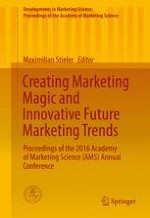2017 | OriginalPaper | Buchkapitel
Need for Touch: A Barrier in Online Shopping—Identifying Compensatory Factors in an Online Context
verfasst von : Jyoti Pandey, Ashish Sadh, Aditya Billore
Erschienen in: Creating Marketing Magic and Innovative Future Marketing Trends
Aktivieren Sie unsere intelligente Suche, um passende Fachinhalte oder Patente zu finden.
Wählen Sie Textabschnitte aus um mit Künstlicher Intelligenz passenden Patente zu finden. powered by
Markieren Sie Textabschnitte, um KI-gestützt weitere passende Inhalte zu finden. powered by
